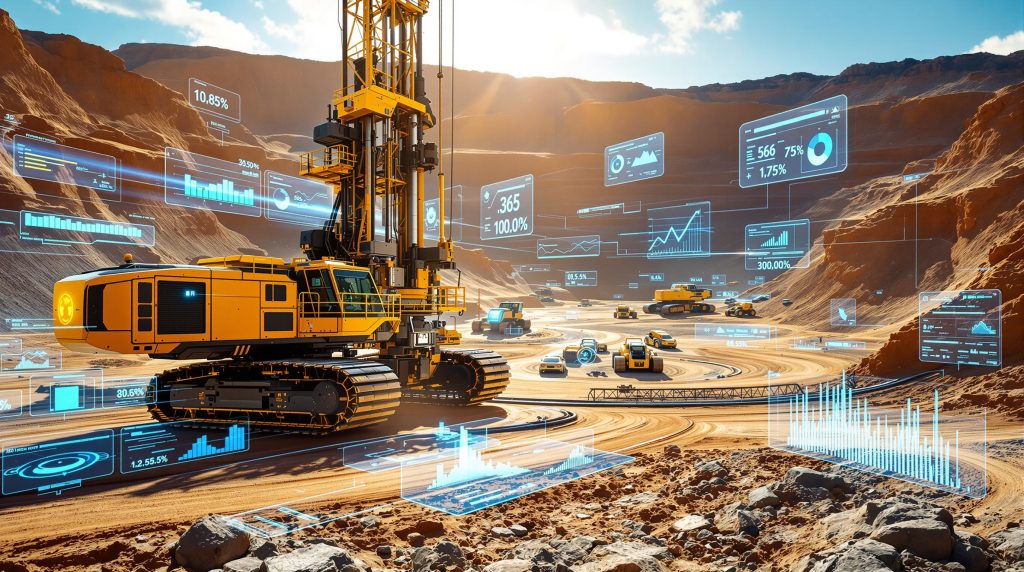Understanding the Revolution in Mining Operations
The mining industry has witnessed a technological transformation that extends far beyond traditional mechanization. Autonomous drilling rigs represent a paradigm shift in how mineral extraction operations approach productivity, safety, and environmental responsibility. These sophisticated systems combine artificial intelligence, advanced sensors, and precise control mechanisms to execute drilling operations without direct human intervention.
Modern autonomous drilling systems integrate multiple layers of technology to achieve unprecedented operational precision. At their core, these machines utilize AI-powered navigation algorithms that process real-time geological data, enabling them to adapt drilling parameters instantly based on changing subsurface conditions. The fusion of LIDAR sensors, GPS positioning systems, and inertial measurement units creates a comprehensive spatial awareness network that guides drilling operations with millimeter-level accuracy.
Core Components of Autonomous Drilling Systems
The technological foundation of autonomous drilling operations rests on several critical components working in harmony. Advanced sensor fusion technology combines multiple data streams to create a complete operational picture, while machine learning algorithms continuously refine drilling patterns based on accumulated performance data.
Remote monitoring infrastructure enables operators to oversee multiple drilling rigs from centralised control centres, sometimes located over 1,000 kilometres away from active mining sites. This capability has proven particularly valuable in remote mining operations where traditional workforce deployment presents logistical challenges.
The evolution of these systems demonstrates remarkable engineering progression. Equipment designed with onboard computers from inception has enabled a natural transition from manual operation to automated processes, ultimately achieving full autonomous functionality. Furthermore, this technological maturation has occurred over the past 25 years, with autonomous operations becoming commercially viable over the last 10 years.
Types of Autonomous Drilling Applications
Surface blasthole drilling in open-pit mines represents the most widespread application of autonomous drilling technology. These operations have demonstrated exceptional success across diverse geological conditions and commodity types, including copper, gold, platinum, phosphate, and iron ore extraction.
The operational scope extends beyond basic hole drilling to encompass complex drilling plans executed with consistent precision. Autonomous systems can maintain optimal drilling patterns across varying terrain conditions, adjusting parameters automatically to accommodate changes in rock hardness, geological structures, and environmental factors.
Underground development applications present unique challenges that autonomous systems are increasingly addressing. The confined spaces and complex navigation requirements of subsurface operations demand specialised adaptations of surface drilling technologies, incorporating enhanced positioning systems and environmental monitoring capabilities.
Quantifying Performance Gains in Modern Operations
The transformation of mining productivity through autonomous drilling rigs has produced measurable improvements across multiple operational metrics. Real-world data from commercial deployments demonstrates substantial gains in drilling precision, operational efficiency, and resource utilisation.
| Performance Metric | Improvement Range | Industry Impact |
|---|---|---|
| Depth Accuracy | 85% increase | Reduced waste and overdrilling |
| Spatial Accuracy | 60% increase | Optimised blast pattern execution |
| Operational Utilisation | 17% higher average | Extended productive hours |
| Autonomous Drilling Volume | 90+ million metres | Proven commercial deployment |
Precision Drilling Capabilities
The accuracy improvements achieved through autonomous drilling systems have translated into significant operational benefits. Enhanced depth accuracy of 85% has enabled mining operations to avoid more than 8 million wasted overdrill metres, representing substantial savings in explosives, processing time, and material handling costs.
Spatial accuracy improvements of 60% have optimised blast pattern execution, ensuring consistent fragmentation and improved ore recovery rates. This precision enables mining engineers to design more effective extraction strategies while minimising environmental impact through reduced overburden disturbance.
GPS-guided positioning systems provide the foundation for these accuracy improvements, enabling consistent hole placement even in challenging terrain conditions. In addition, real-time adjustment capabilities allow autonomous systems to compensate for unexpected geological variations while maintaining predetermined drilling parameters.
Extended Operating Hours and Efficiency
Autonomous drilling systems have achieved 17% higher utilisation rates compared to manually operated equipment, primarily through elimination of human-factor limitations. These systems can operate continuously across multiple shifts without fatigue-related performance degradation or mandatory rest periods.
The cumulative impact of improved utilisation has resulted in over 90 million metres of autonomous drilling completed across global mining operations. This substantial operational volume demonstrates the maturity and reliability of autonomous drilling technology in commercial mining environments.
For instance, automated equipment maintenance scheduling optimises drilling availability by predicting service requirements based on operational data rather than fixed time intervals. This predictive approach minimises unexpected downtime while ensuring equipment operates within optimal performance parameters.
Eliminating Human Exposure to Hazardous Environments
Safety improvements represent one of the most compelling advantages of autonomous drilling implementation. By removing personnel from active drilling zones, these systems eliminate exposure to multiple occupational hazards including equipment-related accidents, environmental dangers, and repetitive stress injuries.
Remote Operation Benefits
The capability to operate drilling equipment from remote control centres provides unprecedented safety advantages. Personnel positioned over 1,000 kilometres away from drilling sites remain completely protected from on-site hazards while maintaining full operational control over drilling activities.
This remote operational capability has proven particularly valuable during extreme weather conditions, geological instability events, and other circumstances that would traditionally require work stoppages. Consequently, autonomous systems can continue operations safely when human presence would be inadvisable or impossible.
Environmental hazard elimination extends beyond immediate physical dangers to include long-term health protection. Operators no longer experience direct exposure to drilling dust, equipment noise, vibration, or diesel emissions that characterise traditional drilling operations. This AI drilling innovation has revolutionised safety protocols across the industry.
Automated Safety Protocols
Advanced safety systems integrated into autonomous drilling platforms provide multiple layers of protection beyond simple remote operation. Real-time hazard detection algorithms continuously monitor environmental conditions, equipment status, and operational parameters to identify potential safety concerns before they escalate.
The Automatic Bit Changer technology demonstrates how automation enhances safety in specific high-risk tasks. Since its 2022 launch, this system has completed over 7,000 automatic bit replacements, eliminating human exposure during one of the most dangerous aspects of drilling operations.
Critical Safety Development: Autonomous drilling systems have enabled operations to continue safely in conditions that would previously require immediate evacuation, including severe weather events, equipment failures, and geological instability situations.
Emergency response capabilities built into autonomous systems include automatic shutdown procedures, immediate notification systems, and fail-safe operational modes that prioritise personnel protection over production continuity.
Sector-Specific Applications and Market Adoption
The versatility of autonomous drilling rigs has enabled successful deployment across diverse mining sectors, each presenting unique operational requirements and challenges. Commercial success across multiple commodity types demonstrates the adaptability and reliability of these systems in varied geological and operational conditions.
Open-Pit Mining Operations
Large-scale copper extraction operations have emerged as primary adopters of autonomous drilling technology, leveraging the precision and consistency advantages to optimise ore recovery from complex geological formations. The technology's ability to maintain accurate drilling patterns across extensive pit operations has proven particularly valuable for copper mining's demanding accuracy requirements.
Gold mining operations have implemented autonomous drilling to address the precision requirements of grade control and ore delineation. The enhanced spatial accuracy enables more effective separation of ore and waste materials, improving overall recovery rates while reducing processing costs.
Iron ore mining operations, including the initial commercial deployment in Australia's Pilbara region, have demonstrated the scalability of autonomous drilling technology. The successful transition from two trial rigs to dozens of global deployment sites illustrates the technology's commercial viability across large-scale operations.
Underground Mining Applications
While surface applications dominate current deployments, underground mining represents a growing application area for autonomous drilling technology. The confined spaces and navigation challenges of subsurface operations require specialised adaptations of surface drilling systems.
Development heading advancement benefits significantly from autonomous drilling precision, enabling accurate tunnel development while maintaining optimal ventilation and support installation requirements. However, the consistency of autonomous operations proves particularly valuable in maintaining tunnel alignment and grade specifications.
Industry Deployment Statistics
Current market penetration demonstrates steady growth across multiple mining sectors. Autonomous drilling rigs now operate at dozens of mining sites globally, representing a significant expansion from initial trial deployments over the past decade.
The geographic distribution of deployments spans multiple continents, with successful implementations across diverse climatic and geological conditions. This global deployment pattern demonstrates the technology's adaptability to varied operational environments and regulatory frameworks.
Advanced Positioning and Control Technologies
The navigation systems powering autonomous drilling operations represent sophisticated integration of multiple positioning technologies. These systems must maintain precise accuracy while operating in challenging environments characterised by dust, vibration, electromagnetic interference, and varying weather conditions.
Surface Navigation Systems
High-precision GPS systems provide the primary positioning reference for surface autonomous drilling operations. These systems achieve centimetre-level accuracy through Real-Time Kinematic (RTK) correction services, enabling precise hole placement according to predetermined drilling patterns.
The 85% improvement in depth accuracy and 60% improvement in spatial accuracy demonstrate the effectiveness of integrated navigation systems in maintaining drilling precision. These performance gains result from continuous position verification and real-time parameter adjustment based on actual versus planned positioning data.
Three-dimensional terrain mapping capabilities enable autonomous systems to adapt drilling parameters based on topographical variations and surface conditions. This adaptive capability ensures consistent drilling performance across varied terrain while maintaining optimal equipment stability and safety margins. The integration of 3D geological modelling further enhances these positioning capabilities.
Environmental Adaptation Capabilities
Autonomous drilling systems incorporate sophisticated environmental monitoring to maintain operational effectiveness across diverse conditions. Temperature compensation systems adjust drilling parameters based on ambient conditions, while dust detection and filtration systems protect sensitive electronic components.
Weather condition response protocols enable systems to modify operations automatically based on environmental factors including wind speed, precipitation, and visibility conditions. These adaptive capabilities ensure consistent performance while maintaining safety standards across varying operational conditions.
Real-time geological adaptation represents one of the most sophisticated aspects of autonomous drilling control. Systems can detect changes in rock hardness, geological structure, and mineral composition, automatically adjusting drilling parameters to maintain optimal penetration rates and hole quality.
Cost Reduction and Return on Investment Analysis
The economic benefits driving autonomous drilling adoption extend beyond simple labour cost reductions to encompass comprehensive operational efficiency improvements. These systems deliver measurable financial returns through multiple mechanisms including reduced consumables waste, improved equipment utilisation, and decreased environmental compliance costs.
Quantified Economic Benefits
Fuel consumption reductions represent a significant component of operational cost savings. Autonomous drilling operations have achieved 85 million litres of fuel savings over the past decade, demonstrating the efficiency gains possible through optimised drilling patterns and reduced equipment idling.
| Economic Impact Category | Measured Results | Financial Significance |
|---|---|---|
| Fuel Consumption | 85 million litres saved | Substantial operational cost reduction |
| CO₂ Emissions | 225,000 tonnes reduced | Environmental compliance benefits |
| Overdrill Waste | 8+ million metres avoided | Explosives and processing cost savings |
| Equipment Utilisation | 17% improvement | Enhanced asset productivity |
The environmental cost reductions provide both direct financial benefits and regulatory compliance advantages. Furthermore, the 225,000 tonnes of CO₂ emissions reduction equals the environmental impact of removing almost 50,000 passenger vehicles from operation annually, providing significant value in carbon credit markets and environmental reporting requirements.
Operational Efficiency Gains
Improved equipment utilisation rates translate directly into enhanced return on capital investments. The 17% higher utilisation achieved through autonomous operation enables mining companies to extract more value from existing equipment investments while delaying or eliminating needs for additional equipment purchases.
Reduced drilling consumables waste through improved accuracy provides ongoing operational cost benefits. The elimination of 8+ million metres of wasted overdrill represents substantial savings in drill bits, fuel consumption, equipment wear, and processing time across multiple operational areas.
Predictive maintenance capabilities enabled by autonomous system data collection reduce both planned and unplanned maintenance costs. Continuous monitoring of equipment performance parameters enables optimised maintenance scheduling based on actual equipment condition rather than fixed time intervals. This approach exemplifies AI-powered efficiency in modern mining operations.
Long-term Investment Considerations
The upgradeability of autonomous drilling systems provides long-term value retention advantages. Continuous software and hardware improvements enable existing equipment to benefit from technological advances without requiring complete system replacement, as noted in industry observations about equipment performance improvements regardless of age.
Capital investment recovery periods for autonomous drilling implementations have demonstrated favourable returns through combination of operational cost reductions and productivity improvements. The sustained operational benefits over 10 years of commercial deployment provide substantial evidence of technology maturity and financial viability.
Technology Providers and Market Leadership
The autonomous drilling market features established mining equipment manufacturers alongside specialised technology developers, creating a competitive landscape that drives continuous innovation and improvement in system capabilities.
Established Equipment Manufacturers
Epiroc has established significant market presence through 25 years of Pit Viper production and 10 years of autonomous operations development. The company's approach of designing equipment with onboard computers from inception has enabled natural progression from manual to autonomous operation.
The Automatic Bit Changer technology launched in 2022 demonstrates ongoing innovation in autonomous drilling systems. This system has completed over 7,000 automatic bit replacements, showcasing the maturity and reliability of advanced autonomous functions beyond basic drilling operations.
Caterpillar's world-first autonomous drilling platform leverages the company's extensive equipment manufacturing experience to provide integrated drilling platforms. Meanwhile, Sandvik's AutoMine drilling systems focus on underground applications, while Komatsu's intelligent drilling platforms emphasise surface mining optimisation.
Market Development Trends
The expansion from initial trial deployments to dozens of global mining sites demonstrates substantial market growth and technology acceptance across the mining industry. This growth pattern indicates mature technology with proven commercial viability rather than experimental or niche applications.
Geographic deployment diversity spanning multiple continents and commodity types illustrates broad market applicability beyond specific mining conditions or regulatory environments. The successful implementation across copper, gold, platinum, phosphate, and iron ore operations demonstrates technological versatility and market potential.
Implementation Challenges and Industry Barriers
While autonomous drilling rigs have achieved commercial success, several implementation challenges continue to influence adoption rates and deployment strategies across different mining operations and geographic regions.
Technology Integration Complexities
Legacy equipment compatibility presents ongoing challenges for mining operations seeking to integrate autonomous drilling systems with existing fleet operations. The need for comprehensive communication networks and standardised data protocols can require substantial infrastructure investments beyond the drilling equipment itself.
Software standardisation across multiple equipment manufacturers and operational systems requires careful coordination to ensure seamless information flow and operational control. Mining companies often operate mixed equipment fleets, necessitating integration solutions that accommodate diverse technological platforms.
However, cybersecurity considerations have become increasingly important as drilling operations become more connected and data-dependent. Protection of operational data and control systems requires specialised security protocols and ongoing monitoring to prevent unauthorised access or system disruption.
Workforce Transition Considerations
The transition to autonomous drilling operations requires comprehensive retraining programmes for existing drilling personnel. While these systems reduce on-site personnel requirements, they create demands for new skill sets in remote operation, system monitoring, and technical troubleshooting.
Change management and technology acceptance represent significant organisational challenges for mining companies implementing autonomous systems. Successful deployment requires addressing workforce concerns about job security while demonstrating the enhanced safety and operational benefits of autonomous technology.
Regulatory and Compliance Factors
Safety certification requirements for autonomous drilling equipment vary across different mining jurisdictions, creating compliance complexity for companies operating in multiple regions. International standards development continues to evolve as autonomous technology becomes more prevalent in mining operations.
Environmental impact assessments for autonomous drilling operations must address both the positive effects of reduced emissions and fuel consumption alongside potential concerns about increased operational intensity and site access requirements.
Future Technology Development and Industry Trends
The evolution of autonomous drilling technology continues to accelerate through advances in artificial intelligence, connectivity infrastructure, and environmental sustainability initiatives. These developments promise to further enhance the capabilities and applications of autonomous drilling systems.
Artificial Intelligence Enhancement
Machine learning algorithm improvements enable autonomous systems to develop increasingly sophisticated responses to geological variations and operational challenges. The accumulation of 90+ million metres of operational data provides substantial training datasets for AI system enhancement and optimisation.
Predictive maintenance capabilities continue advancing through enhanced data collection and analysis systems. Real-time equipment condition monitoring enables increasingly accurate prediction of maintenance requirements, reducing both planned and unplanned downtime while optimising maintenance resource allocation.
Connectivity and Data Integration
The expansion of high-speed communication networks enables more sophisticated remote operation capabilities and real-time data sharing between drilling sites and control centres. Enhanced connectivity supports more detailed operational monitoring and faster response to changing conditions or equipment issues.
Cloud-based data processing and storage systems provide mining companies with enhanced analytical capabilities and improved data security. These systems enable comprehensive performance analysis across multiple drilling sites and equipment platforms while supporting predictive analytics and operational optimisation.
Digital twin technology development offers potential for virtual testing and optimisation of drilling operations before physical implementation. This capability could enable more effective drilling plan development and equipment configuration optimisation based on site-specific conditions and requirements. Such advances align with broader data-driven mining transformation initiatives.
Sustainability and Environmental Focus
Electric and hybrid power system development addresses mining industry pressures for reduced emissions and environmental impact. The 225,000 tonnes of CO₂ reduction already achieved through improved efficiency demonstrates the environmental benefits possible through technological optimisation.
Circular economy principles in equipment design focus on extending equipment life cycles and improving component recyclability. The demonstrated ability to upgrade existing equipment rather than requiring complete replacement supports sustainable resource utilisation approaches.
Implementation Strategy and Best Practices
Mining companies considering autonomous drilling adoption can benefit from structured approaches that minimise implementation risks while maximising operational benefits. Successful deployments demonstrate clear patterns of effective implementation strategies and change management practices.
Proven Implementation Approaches
The successful progression from initial two-rig trials to dozens of global deployment sites illustrates effective scaling strategies for autonomous drilling implementation. This phased approach enables companies to develop operational expertise while demonstrating technology benefits before major fleet conversions.
Pilot project selection should focus on operations with suitable geological conditions, adequate infrastructure support, and organisational readiness for technological change. The Pilbara iron ore mining trial demonstrates the importance of selecting sites with appropriate operational characteristics for initial implementations. Companies can benefit from accessing drilling program insights before implementation.
Success Factors for Deployment
Comprehensive change management programmes prove essential for successful autonomous drilling implementation. Organisations must address both technical integration requirements and workforce adaptation needs to achieve optimal operational results and stakeholder acceptance.
Strong leadership commitment and clear communication about technology benefits help organisations navigate implementation challenges while maintaining operational continuity. The sustained growth from trial to commercial deployment demonstrates the importance of long-term organisational commitment to technology adoption.
Performance Monitoring and Optimisation
Continuous improvement processes enable mining operations to optimise autonomous drilling performance over time. The demonstrated improvements in depth accuracy, spatial accuracy, and utilisation rates result from ongoing system refinement and operational optimisation based on accumulated experience.
Regular performance assessment and system updates ensure that autonomous drilling operations continue delivering expected benefits while adapting to changing operational requirements or site conditions. The ability to upgrade existing systems provides long-term value retention and performance enhancement opportunities.
Note: This analysis is based on available industry information and reported performance data. Mining companies should conduct comprehensive site-specific assessments and consult with equipment manufacturers and industry experts before making autonomous drilling investment decisions. Performance results may vary based on specific geological conditions, operational requirements, and implementation approaches.
Looking for the Next Mining Technology Breakthrough?
Discovery Alert's proprietary Discovery IQ model delivers instant notifications on significant ASX mineral discoveries, helping investors identify companies pioneering revolutionary mining technologies like autonomous drilling systems. Start your 30-day free trial today to gain immediate access to actionable investment opportunities in the rapidly evolving mining sector.




